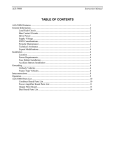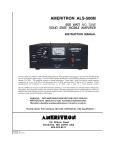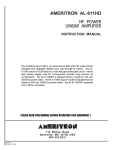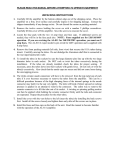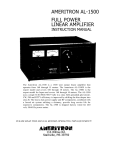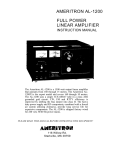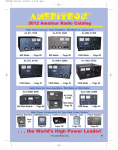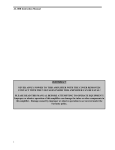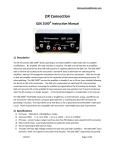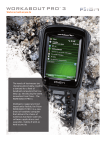Download AMERITRON AL-811H Specifications
Transcript
PLEASE READ THIS MANUAL BEFORE ATTEMPTING TO OPERATE EQUIPMENT!! UNPACKING INSTRUCTIONS 1. Carefully lift the amplifier by the bottom cabinet edge out of the shipping carton. Place the amplifier on a firm, level surface and carefully inspect it for shipping damage. Contact the shipper immediately if any damage exists. Save the carton and packing material for possible shipping in the future. 2. Remove the twelve screws holding the cover on with a number 2 phillips screwdriver. Carefully lift the cover off the amplifier. Save the screws to rescuer the cover. Note that the AL811H is shipped with the fuses and fuse caps inside the amplifier. 3. Locate the fuse pack with the two 12 ampere fuses and fuse caps. If additional screws are needed, they will be in the fuse pack also. NOTE: Fuses supplied are for 120/110/100V operation (Models AL-811H/HY). If you are rewiring the AL-811H for 240/230/220V operation, you must use 8 ampere fuses. The AL-811HX export model is pre-wired for 240V operation and is supplied with 8 ampere fuses. 4. Remove the foam packing material (around the tubes) that secures the 811A tubes during transit. Carefully unwrap the tubes. Do not dislodge or break the shaft that is connected to the rear input bandswitch wafer. 5. To install the tubes in the sockets, be sure the large diameter pins line up with the two large diameter holes in each socket. Do NOT rock or twist the tubes excessively during the installation. If the tubes are already installed, check them for proper seating. If necessary, press the tubes down into their sockets with gentle force. Do not rock or twist the tubes excessively. Also, check that the anode caps are secure and that they did not come loose during the unwrapping process. 6. The white ceramic anode connector will have to be removed from the top metal cap of each tube if it ever becomes necessary to remove the tubes from the amplifier. This can be a difficult procedure because the high clamping force of the internal springs in the anode connector may hold it to the cap very tightly. The tube will break if direct upward or rocking pressure is applied in an attempt to remove the connector. The safest way to remove the ceramic connector is to lift the tube out of its socket. A twisting or spinning pulling motion can then be applied while holding the ceramic connector firmly until the tube and connector are separated. Repeat the procedure with each tube. 7. Install the cover with the vent holes to the left (near the tubes) by installing the back screws first. Install all the screws loosely and tighten them only after all the screws are in place. 8. Install the fuses and fuse caps on the back of the unit. Read the manual to become familiar with the operation of the AL-811H amplifier. AL-811H LINEAR AMPLIFIER FEATURES The AL-811H is a grounded grid linear amplifier developed by Ameritron using low cost 811A power triodes. It operates in class AB2 for SSB and CW. 1. Fast Warm Up Time: The 811A tubes take approximately 10 seconds to warm-up. 2. Long Tube Life: The 811A tubes are long life, reliable transmitting tubes. 811A tubes offer rugged, reliable operation even on RTTY and SSTV. 3. Tuned Input: A Pi-Network tuned input matches the 811A tubes to 50 ohm exciters. 4. Two Illuminated Panel Meters: The AL-811H has two illuminated panel meters. The Grid Current meter provides a continuous reading of the 811A grid current to indicate proper loading of the amplifier. The other meter switches between high Voltage (HV) and Plate Current (Ip). 5. Multi-voltage Heavy Duty Transformer: A unique "buck-boost" winding allows adjustment of primary voltages to match a wide range of line voltages centered on 110 and 230 volts. This versatile Ameritron feature allows the user to maintain optimum voltages on the tubes and other components to obtain maximum performance and life. 6. Vernier Plate and Load Adjustments: Both tuning controls have vernier 6:1 reduction drives for smooth tuning logging scales for accurate and rapid tune-up. 7. Safety interlock: AC input power is removed from the transformer when the cover is removed. Never attempt to defeat this switch. 8. 9. Operate/Standby Switch: Used to remove the amplifier from the RF line while filament and plate voltages are maintained during "barefoot" operation. XMT Indicator LED: Provides a front panel indication of proper amplifier keying by the exciter. 10. ALC: The drive level is detected to provide a control voltage for the exciter. ALC prevents over-driving of the linear and reduces distortion from excessive drive power. 11. Neutralization Circuit: improve performance. Reduces unwanted feedback to CAUTION: This amplifier must be disconnected from the power mains before removing the cover. See the precaution on page 7. Domestic model(AL-811H): 160, 80, 40, 30, 20, 17 and 15 meter bands Export model(AL-811HX/HY): 160, 80, 40, 30, 20, 17, 15, 12, and 10 meter bands. Input Circuit type: Pi-network, slug tuned coils Maximum VSWR at resonance: 1.3:1 Minimum 2:1 VSWR bandwidth: 15% Maximum drive power permissible: 85 watts Typical drive for rated output: 65 watts Output (7MHz) Typical SSB PEP voice operation: over 800 watts continuous Typical CW continuous operation: 600 watts 1/2 hour PEP two tone: 650 watts 1/2 hour continuous carrier: 400 watts ALC Negative going, 0-12V, adjustable, phono jack Power Supply Circuit type: full wave bridge rectifier No load voltage: 1700V Full load voltage: 1500V Full load current: 700mA Regulation: 15% Maximum draw at rated output: 10A (120V) AC Input: 120V, 50/60 Hz (AL-811H/HY 240V, 50/60 Hz (AL-811HX) Metering Multimeter: reads HV and plate current Grid meter: reads PA grid current Connectors Relay: keys amplifier when grounded. Sources +12 VDC open circuit and supplies 100mA when grounded. A built-in pulse canceling diode protects the exciter. RF input: SO-239, 50 ohm input. RF output: SO-239, 50 ohms with full power, into any SWR below 3:1. Power: NEMA 5-15P 120V grounded style. ALC: Phono Jack. Supplies up to 12 volts of negative voltage for ALC control of exciters. Physical Dimensions: 15.5" D x 13.75"W x 8.25" Weight: 30 lbs. *Specifications are subject to change without notice or obligation. Exact performance measurements may vary due to the accuracy of the test equipment and the measurement methods used. TECHNICAL SPECIFICATION AL-811H* Frequency Coverage 2 GENERAL INFORMATION SAFETY INTERLOCK The interlock switch stays closed to allow AC line voltage to reach the power transformer as long as the AL-811H's top cover is in place. When the top cover is removed, the interlock opens and disconnects the input line voltage. This does not discharge the bank of power supply filter capacitors. Be sure to allow the filter capacitors to discharge before you touch anything inside the amplifier. You can select the High Voltage function of the Multimeter to check the high voltage potential. WARNING: never remove the cover of this amplifier with the unit plugged into the power line. DRIVING POWER This amplifier is designed to operate at full ratings when it is driven by an exciter that has approximately 70 watts of RF output. You can use an exciter that has lower output power, but the amplifier's output may be less. If you use an exciter that delivers more than 70 watts, carefully adjust the driving power to avoid "over drive" and the creation of spurious signals, which could create needless interference to other operators. We highly recommend that you use a monitor scope for continuous output monitoring. The display on an oscilloscope is the best readily available way of determining the amplitude of the voice peaks which, if excessive, can cause "flat topping" and splatter. IMPORTANT: Do not increase the drive power unless the amplifier output power also increases. Grid current climbs rapidly and the plate current meter and output power will barely increase with excessive drive. This condition indicates the amplifier LOAD control needs to be advanced to a higher number. Excessive plate current indicates the drive power limit has been reached. Non-linear operation, splatter, and excessive grid current will occur if the "LOAD" setting it too low. FILAMENT SUPPLY The filament circuit of this amplifier satisfies all requirements of the tube manufacturer related to tube performance and life. Inrush current is controlled by the transformer's internal resistance and impedance, filament choke resistance, and filament wiring resistance. To insure maximum life of the tube, never replace any circuit components or wiring with substitute parts. ALC CIRCUIT The ALC circuit converts a portion of the RF drive voltage at the exciter end of the tuned input circuit to a negative going control voltage. This voltage should be used to limit the exciter drive to safe drive levels for the AL-811H for exciters that develop more than 70 watts of output power. A capacitive divider consisting of C27 and C28 is used to reduce the RF voltage and drive a rectifier circuit consisting of D17 and D18. The resulting voltage is filtered by C29 and R12 and is applied to the ALC potentiometer R14. R13 provides RF and DC isolation for the ALC jack. The DC isolation prevents loading of the exciter ALC input line by the ALC potentiometer. The ALC circuit can be adjusted by loading the AL-811H slightly beyond the recommended maximum values with the 3 ALC line disconnected. The ALC line can then be connected and the ALC control on the amplifier can be adjusted to a point just before the drive begins to decrease. NOTE: The primary use of the ALC function is the prevention of excessive drive levels. This circuit will not prevent small changes in output power from occurring on different bands. Under most conditions destructive levels of drive power are those above 100 watts. Slight changes may occur in maximum output power on different frequencies with the ALC connected. A compromise in ALC adjustment may be necessary to achieve acceptable performance on all bands. PLATE SUPPLY The power supply in this amplifier uses a combination plate, filament and control transformer. A buck boost winding is provided to allow the user to compensate for low, medium or high power line voltage. This amplifier is normally supplied wired for the highest power line voltage setting. Never change this setting unless you are positive that performance is suffering due to low filament and plate voltages. The life of components will be shortened drastically if the high voltage exceeds 1800 volts at rest. The diagram on page 4 shows proper wiring for each voltage. Never attempt to rewire this amplifier while it is connected to power. EXPORT MODIFICATIONS A simple modification will allow operation on frequencies above 15 meters. Instructions for this modification are available by sending a written request for "Export Modification Instructions" along with a copy of a valid amateur license. There is no charge for this information. Export models are shipped with this modification and have either "X" or "Y" following the serial number. Standard frequency coverage is indicated in the chart on page 7. TECHNICAL ASSISTANCE Technical assistance is available during our normal business hours on weekdays. the following information is required to assist you with operational problems: 1. 2. 3. Model and Serial Number Date of purchase and dealer An accurate description of the problem Meter readings at all stages of the tuning procedure are very important along with a complete description of the other equipment used with our product. Written assistance is also available. Due to time delays in processing mail, please allow at least three weeks for a written reply. AMERITRON 116 Willow Road Starkville, MS 39759 Telephone: (601) 323-8211 Fax: (601) 323-6551 METERING FUNCTIONS The AL-811H has two illuminated panel meters. The right meter reads PA grid current up to 200mA. The normal current with a single tone (carrier) signal will be 150mA to 175mA. If the current is too high during full power operation, the loading control should be advanced to a higher setting. If the current is too low, the loading control should be turned to a lower setting. The left meter reads PA high voltage up to 2000 volts and plate current up to 750mA. The normal readings are 1400-1600 volts HV and 650mA of current at full rated output with a single tone signal. INSTALLATION LOCATION Do not operate the amplifier in excessively warm locations or near heating vents or radiators. Be sure air can circulate freely around and through the amplifier cabinet. Provide an unobstructed air inlet for the blower. Do NOT place any books, magazines or equipment that will impede the free flow of air near the sides of the cabinet. VENTILATION The AL-811H ventilation system has been designed and tested to maintain the 811A tube temperature safely below the tube manufacturer's rating at 500 watts output with a 100% duty cycle. To insure proper ventilation in your installation, observe the following: 1. Do not block or restrict the ventilation holes in the cover. 2. The exhaust air flow is over 20 CFM. Do not "assist" the air flow unless the fan exceeds the AL-811H fan CFM by a factor of 2:1. 3. Do not mount additional fans on the AL-811H cabinet. 4. The exhaust air will become warm at high power levels. Do not place any heat sensitive objects in the exhaust air stream. GROUNDING perform equally well with a power line frequency of 50 Hz or 60 Hz. The Transformer Connections chart at the bottom of this page shows proper connections for various line voltages. WARNING: The green wire connects to the chassis of the amplifier and it must connect to the safety ground of the outlet. The AL-811HX (export model) is wired for 240V, 50/60 Hz operation. The appropriate plug is not provided for this model. You must wire the proper plug on the end of the power cord supplied. Simply cut the existing plug off and wire the appropriate plug in its place. If the line voltage in your country is not 240V, then you must change the transformer to the appropriate setting indicated by the chart below. Note: the AL811H transformer allows operation on 100V line voltage in countries such as Japan. NEVER REWIRE THE POWER SUPPLY TO BOOST THE HIGH VOLTAGE ABOVE 1800 VOLTS. ALSO, DO NOT ATTEMPT TO REWIRE THIS AMPLIFIER WHILE IT IS CONNECTED TO POWER. The wiring between the fuse box and the amplifier AC outlet must be 14 gauge or larger in order to supply the operating current required (10 amperes) without a significant drop in the line voltage. The outlet should be fused for the wire gauge used. Connect a good earth or water pipe ground to the ground post on the rear panel of the amplifier. Use the heaviest and shortest connection possible. Before you use a water pipe ground, inspect the connections around the water meter and make sure that no plastic or rubber hose connections are used. These connections interrupt electrical continuity to the water supply line. Install a jumper around any insulating water connections you may find. Use heavy copper wire and pipe clamps. It is best to ground all equipment to one point at the operating position and then ground this point as described above. POWER CONNECTIONS The AL-811H is supplied with a NEMA 5-15P plug for 120V operation. The power required to operate the AL-811H/HY is not high enough to warrant 240V operation unless 120V is not available. The fuses should be 12 ampere fuses for 120V and they must be changed to 8 amperes for 240V operation. The diagram to the right shows the proper wiring for 120V operation. *Factory wired operation for the AL-811H **Factory wired operation for the AL-811HX VOLTAGE BUCK BOOST PRIMARY *120 A to 1, B TO 2 C to D, E to F 110 1 to 2, (A,B OPEN) C to D, E to F 100 A to 2, B to 1 C to D, E to F For 240, 230, 220 all three primary conditions apply ↓ **240 A to 1, B to 2 no connection C to D 230 1 to 2, (A,B OPEN) D to E 220 A to 2, B to 1 no connection E to F Operation on a voltage of 240V is not required, nor will it necessarily improve performance. The power transformer will 4 INTERCONNECTIONS 1. Connect the RF output of the transmitter or transceiver to the RF IN connector on the rear of the AL-811H with 50 ohm coax. Use any 50 ohm cable (RG-58 is fine) with PL259 plugs. 2. Connect the existing station antenna system to the RF OUT connector on the AL-811H with any 50 ohm coaxial cable capable of carrying 650 watts. 3. 5 Use shielded audio type cable with standard male phono plugs to connect the RELAY jack on the AL-811H to the exciter's normally-open amplifier keying circuit. The keying circuit in the AL-811H has a positive 12 VDC open circuit and it provides 100mA of current when connected to ground. The AL-811H has an internal back-pulse canceling diode across the relay coil. 4. Connect the shortest possible ground lead from a good earth ground to the GND terminal. The best leads are solid (instead of stranded or braided) copper. It is also best to use a common ground point for all the equipment in the station. 5. Use a shielded audio cable with standard male phono plugs to connect the ALC out jack on the back of the amplifier to the negative going ALC input jack on the exciter. Do not connect this line until you have read and understand the function of the ALC circuit. Exciters with output powers below 70 watts do not normally require this connection. If this jack is connected without adjusting the ALC control, the exciter may not develop any drive power. TUNE-UP CW PROCEDURE Follow the instructions in numerical order. If the various meter readings are different than those indicated in the instructions, check the connections from the exciter to the amplifier and make sure they are correct. Consult the manual for the exciter, if necessary. Be sure the transformer is correctly wired for your line voltage. See the POWER CONNECTIONS instructions on page 4 for wiring details. 1. Set the AL-811H front panel switches as follows: POWER/OFF-ON to OFF XMT/OPR-STBY to STBY METER/Ip-HV to HV 2. Plug the line cord into a proper voltage outlet. 3. Set the POWER switch to the ON position. The meter lamps should light and the fan should start. Read the 2000 volt scale on the multimeter. It should indicate 1700 volts nominally and no more than 1800 volts. 4. With the amplifier XTM switch still on STBY, tune the exciter into the normal 50 ohm load according to the manufacturer's instructions. Turn the exciter drive fully down after tuning. 5. Place the amplifier bandswitch on the same band as the exciter, the PLATE control in the dial range for the band selected, and the LOAD control as indicated: MHz Plate Load MHz Plate Load 1.80 1 1/2 6 1/2 10.1 7 1/2 0 1.90 3 7 1/2 14.0 9 3 3.5 5 2 18.1 9 2 1/2 3.7 6 3 21.0 9 1/2 4 4.0 6 1/2 5 1/2 24.9 9 1/2 4 1/2 7.0 8 3 28.5 9 1/2 5 7.3 8 3 1/2 6. With the exciter drive still at zero, place the METER/HVIp switch in the Ip position. Observe the 750mA scale. It should read zero. Place the XMT/STBY-OPR switch in the OPR position. 7. Key the exciter (no drive). The Transmit (XMT) LED should light. Observe the plate current on the 750mA scale. It should be 125mA. NOTE: The no drive current will vary up to 25% due to component and line voltage tolerances. 8. Apply only enough drive to indicate a grid current of 100mA, or an Ip of no more than 450mA. Tune the PLATE control for maximum output power. It is normal for the plate current to dip at this point. If the grid current goes over 200mA, reduce the drive at once. Unkey the exciter. 9. Observe the output on an external RF wattmeter. Increase the drive until full exciter power (never to exceed 80 watts) or 200mA of grid current, is achieved. Quickly adjust the PLATE and LOAD controls for maximum output power. 10. Reduce the drive until the desired output levels are obtained. NOTE: Rotating the LOAD control clockwise reduces grid current for a given amount of drive. If the LOAD control is set at too low a numerical setting, a severe stress on tank components may occur. The PLATE control should always be peaked for maximum grid current or output power. Do not exceed 750mA of plate current during tune-up. 6 OPERATION OF OTHER MODES SSB: Tune up the exciter and amplifier as described in TUNE UP section and switch the exciter to SSB. Normal ranges of meter readings on SSB are between 20 and 50 percent of the CW carrier readings. This is due to the different peak-to-average power ratios in the operator's speech waveform. The only true way to measure peak output power is with a good peak reading wattmeter or monitor scope. A whistle should produce the same values obtained on CW. Any effort to run more than these values will produce splatter and distortion. FM, RTTY, PACKET, AMTOR: The plate current should be limited to 400mA maximum. The grid current should be limited to 120mA and the amplifier should be tuned for peak output power with the drive reduced to hold the grid and plate currents below the ratings given. NOTE: Some exciters put out short duration high power RF pulses when first keyed. Exciter power output peaks may reach or exceed full output level settings even if the exciter's power control is adjusted to deliver a fraction of full power under "keydown" conditions. The amplifier loading control must be set high enough (clockwise) to prevent extremely high energy levels from developing in the plate and grid circuits of the amplifier. DO NOT "UNDERLOAD" THE AMPLIFIER TO REDUCE POWER. Never "retune" the amplifier to produce higher efficiency with reduced drive except under the FM, RTTY, PACKET, and AMTOR section. Poor linearity, splatter, or even damage to components, may result from failure to follow instructions. QSK OPERATION The open frame relay in the AL-811H takes approximately 15ms to switch states. This precludes using the standard internal relay for QSK CW operation. Commonly available vacuum relays are very marginal for high speed QSK operation. At 60 WPM less than 50% of the available receive time can be used due to the slow speed of vacuum relays. On PACKET, AMTOR and other modes delay can be added to the transmit and receive changeover to use either vacuum or our standard conventional relay effectively. Ameritron offers a high speed switching option for operators who require high speed switching between receive and transmit. The system switches in one mS. Therefore, these systems are several times faster than available vacuum tube relay systems and they allow over 90% of the available receive time to be used at 60 WPM. The QSK-5 stand alone PIN diode switch can be used with almost all types of amplifiers and transmitters. No modifications are required to the amplifier with the QSK-5. Contact Ameritron for details on the QSK-5. The AL-811H will operate with full output on all WARC bands except 24.5 MHz The AL-811HX/HY will operate with full output on all WARC bands STANDARD FREQUENCY COVERAGE AL-811H 160 meters 80 meters 40 meters 30 meters 20 meters 17 meters 15 meters 1.8 - 2.0 MHz 3.5 - 4.0 MHz 7 - 7.3 MHz 10.1 - 10.15 MHz 10.4 - 14.35 MHz 18.1 - 18.2 MHz 21.0 - 21.45 MHz AL-811HX/HY 160 meters 1.8 - 2.0 MHz 80 meters 3.5 - 4.0 MHz 40 meters 7 - 7.3 MHz 30 meters 10.1 - 10.15 MHz 20 meters 14.0 - 14.35 MHz 17/15 meters 18.1 - 21.45 MHz 12/10 meters 24.9 - 29.7 MHz WARNING!! DO NOT ATTEMPT TO PUT THIS AMPLIFIER IN SERVICE WITH THE COVER REMOVED! CONTACT WITH VOLTAGES INSIDE THIS AMPLIFIER CAN BE FATAL! ALWAYS DISCONNECT THE AMPLIFIER FROM THE POWER MAINS AND WAIT FOR THE FILTER CAPACITORS TO DISCHARGE BEFORE REMOVING THE COVER. 7 PERIODIC MAINTENANCE The high voltage present on the plate choke and air variable capacitors attract dust and dirt out of the air stream. It is particularly important that the high voltage areas at the bottom of the of the plate choke and the insulator on the air variable capacitors be dust free. These areas should be inspected every few months if the amplifier is operated in a dusty environment. connect a jumper wire from ground to the anode connection of the tubes. NOTE: This is a safety wire that must be installed when beginning service work and must be removed when work is finished. Use a soft bristle brush dipped in alcohol to clean previously mentioned areas. Unplug the line cord, and wait at least 90 seconds until the power supply capacitors discharge. Remove the cover and Amplifier Tuning Chart Log BAND LOAD PLATE 160 CW 160 SSB 80 CW 75 SSB 40 CW 40 SSB 30 CW 20 CW 20 SSB 17 CW 17 SSB 15 CW 15 SSB Fill in this chart with your actual settings and you can quickly change bands in the future. We suggest you use a pencil as settings may change as you alter your antennas. NOTES: AL-811H SCHEMATIC 8 Power supply shown wired for 120V operation * 9 AL-811H INPUT CHART BAND C3 (pF) L1 C4 (pF) 160 80 40 100 (208-5174) 750 (208-5668) 28.75T (405-1287) 23.75T (405-1237) 13.75T (405-1137) 20/30 15/17 10/12 330 (208-5331) 120 (208-5606) 180 (208-5605) 9.75T (405-1097) 6.75T (405-1067) 4.75T (405-1047) 1300 (208-5177) 500 (208-5691) 500 (208-5691) 120 (208-5606) 270 (208-5775) 150 (208-5396) 100 (208-5174) PARTS LIST Designation B1 C1, 2, 21, 22 C3, 4 C5, 7, 19, 37 C6 C8-11, 29, 30, 32-36 C12, 27 C13, 31 C14 C15, 16, 17, 18 C20 C23, 25 C24 C26 C28 D1 D2, 16 D3 D4 - 15 D17, 18 DL1, 2 J1, 2 J3, 4 L1 L2 L3 L4 L5 L6 M1 M2 R1 R2, 3, 4, 5 R6, 7 R8 R9 R10 R11 R12 R13 R14 R19-22 PC 15-18 RL1 S1A S1B S2 S3, 4 S5 T1 T2 V1, 2, 3, 4 F1 Description Fan 0.01 uF, 250VAC/1.4KVDC Dis. See Input Chart 0.01 uF, 50V Disc 2200 uF, 25V Elec. 0.01 uF, 1kV Disc 27 pF, 500V DM10 0.001 uF, 7.5kV, Disc Air Variable 210 uF, 450V 0.1 uF,50V Disc 360 pF, 1000V DM19 500 pF, 1000V DM15 Air Variable 150 pF, 500V DM15 Bridge Rectifier 1N4007 MV6753 Red LED 1N5408 1N34A Meter Lamp SO-239 Single Phone Jack See Input Chart Choke Filament 2.5mH Choke 5 1/2 inch Plate Choke #16 Air Coil HF Coil Plate HV/IC Meter Grid Current Meter 33 ohm, 1/4 Watt 50k, 7 Watt, Type 170S 1 Meg 3 Watt 1.5 Ohm 3Watt, Type 135 .6 Ohm, 3 Watt, Type 135 330 Ohm 1/4 Watt 180 Ohm 1/4 Watt 3.3k Ohms 1/4 Watt 10k Ohm 1/2 Watt 100k Ohm, Potentiometer 51 Ohm, 2 Watt, 100 Ohm, 2 Watt 12 VDC Relay Wafer Switch Band Switch Rocker Switch w/Light SPST Switch Safety Interlock Switch Power Transformer Neutralizing Transformer 811A Tube 12 Amp (120 Vac Operation) Ameritron Part # 410-3583 200-2122 200-0416 203-0207 200-2121 208-5404 200-7224 204-2572-1 203-0578 200-0754 208-6688 208-6691 204-2113 208-5396 300-9646 300-0266 320-0522-1 300-0145 300-0346 420-0320 610-2126 600-1225 10-15115 402-1162 10-15197 404-0811 10-13140 400-2601 400-2600 100-1330 103-7580 103-2223 103-3400 103-3399 100-2330 100-2180 100-3330 101-4100 105-1341 103-2151-1 103-2180 408-6140 500-4811 500-2811 507-1157 507-1147 504-3247 406-1532 10-14194-H 350-0811C 755-1412 10 F2 11 8 Amp (240 Vac Operation) 755-1432











